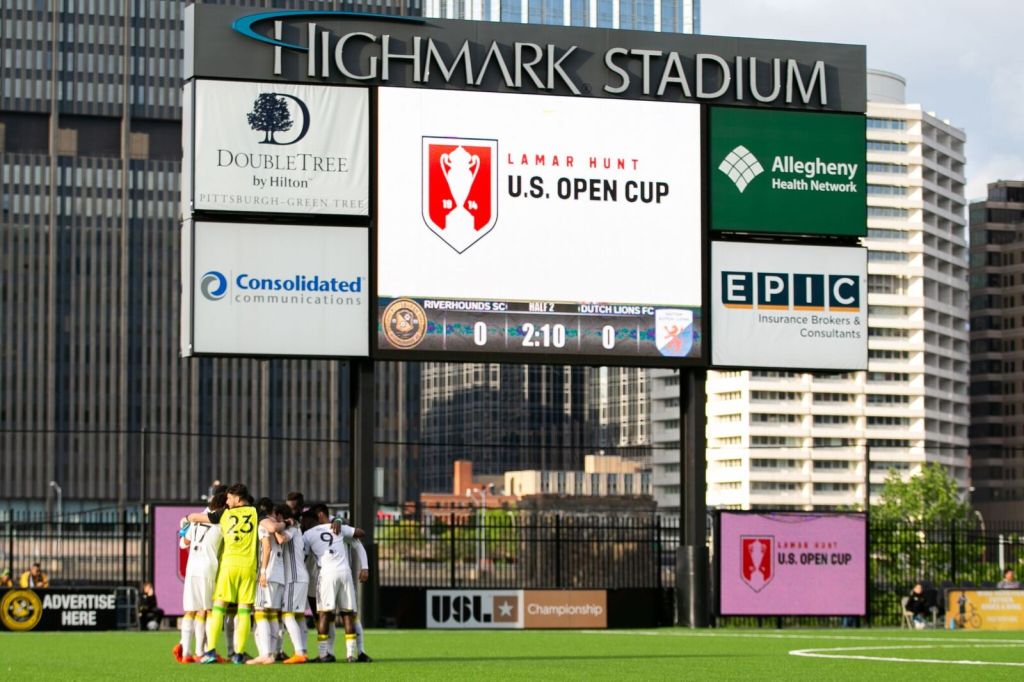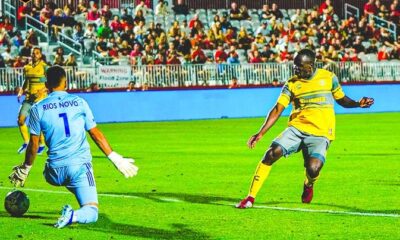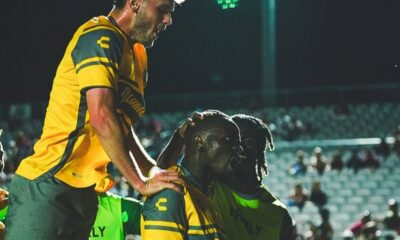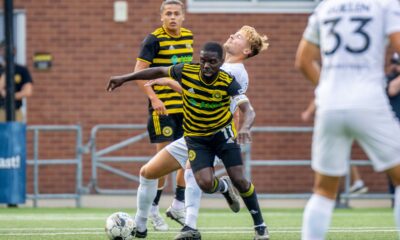
For more on U.S Open Cup, visit thecup.us / US Soccer
For the second time in three years, the US Soccer Federation has announced the largest tournament in the Modern Era (1995-present) of the Lamar Hunt US Open Cup.
A total of 103 teams, including a record-breaking 71 professional teams (previously set in 2019 with 52 pro teams) and 32 Open Division teams, are set to compete for the 107th edition of America’s national championship.
Locally, the lone representative from Western Pennsylvania will be USL Championship’s Pittsburgh Riverhounds SC. The Hounds last participated in the Open Cup in 2019, when they advanced to the Fourth Round, where they were defeated by Major League Soccer’s Columbus Crew, 1-0.
‘Gutsy’ Hounds run out of steam in Open Cup loss at Columbus
The Hounds and 22 other USL Championship (Division II) teams are scheduled to join the tournament in the second round, which will be slated for April 5-7 window. They will either face a first-round winner (from Open Division teams), or a DIvision III club (23 teams have entered from NISA, USL League One, MLS NEXT Pro).
There are numerous possibilities for who the Riverhounds SC could play, but since the Open Cup competition remains largely regional in the early rounds, it’s quite possible that the Hounds could draw the new MLS Next Pro’s (Division III), Rochester NY FC.
The former Rochester Rhinos, previously coached by current Hounds boss Bob LIlley, are returning to professional play and the competition for the first time since 2017. The 1999 US Open Cup champions are the last non-MLS (Division 1) team to win the competition and were recently purchased by Leicester City FC star Jamie Vardy.
The next closest Division III clubs would be AC Syracuse Pulse or Hounds’ Old Guard Shield foe Richmond Kickers. If the Hounds would draw a first-round winner, some of the nearest clubs participating include NPSL sides Cleveland SC or Motown FC. There’s also the fascinating possibility that the 2019 U.S. Adult Soccer Association National Amateur Cup champion Lansdowne Yonkers FC (previously known as the Lansdowne Bhoys), could be in the mix too, as they earned a spot in the tournament in the first round.
If you may recall, the Hounds were dealt one of the most humiliating defeats in franchise history in 2016, when the Bhoys came to Highmark Stadium, stunning the hosts in a 2-0 second round victory in the 2016 edition of the Cup competition.
WINLESS RIVERHOUNDS UPSET BY LANSDOWNE BHOYS IN #USOC2016 2nd RD
Also announced was the pairing methodology for each round of the competition. It’s been mostly unchanged from the canceled 2020 tournament, but there are a couple alterations. (You can find the full list and methodology at the bottom of this article)
Last month, US Soccer announced 25 MLS teams, 2 MLSNP teams, 11 Open Division Local Qualifiers, and the USASA Amateur Cup champion would participate in the 2022 tournament. Along with those teams, 23 USL Championship, 10 NISA, 11 USL League One, 10 NPSL, and 10 USL League Two teams will participate for this tournament starting on March 22-23.
Of note, the number of Open Division teams is a reduction from the 38 proposed for the 2020 tournament. However, it is the same number of teams that actually competed in 2019.
The 2022 US Open Cup winner will earn $300,000 in prize money and a berth in the 2023 CONCACAF Champions League. The runner-up will earn $100,000, while the team that advances the furthest from each of the three lower divisions (Second, Third, and Open) will each earn $25,000. This adds up to a grand total of $475,000 in prize money, the same amount awarded in 2019.
Additional announcements include the introduction of five normal substitutions in regulation, with one normal substitution added in extra time. These substitutions must be made at halftime or in three windows during regulation. For matches that advance to extra time, substitutions can be made before the first extra time period, at halftime of extra time, or during an additional normal substitution window that becomes available during extra time. The 2022 tournament will also be taking part in the concussion substitution trial, allowing teams up to two concussion substitutes and two concussion substitution windows. When a concussion substitute is used, the opponent will receive an additional substitute and additional substitution window.
Finally, in a new competition policy, if a tournament match has kicked off and is terminated prior to the end of the first half or is otherwise tied at the time of termination, and the termination is not due to the conduct of one of the teams, the match shall be restarted at the point of termination (if restarted within two days of the original match date). These games are required to be rescheduled for the next day unless mitigating circumstances prevent this. Otherwise, the match shall be replayed in its entirety if the rescheduled date is three or more days following the original match date.
Pairing Methodology
With the new format of 17 MLS teams starting in the Third Round of the competition, there have been a couple changes to how teams are paired in each round of the competition.
First Round (March 22-23)
Number of Games: 16
Participants: 32 Open Division teams (11 local qualifiers, 1 USASA Amateur Cup champion, 10 NPSL, 10 USL League Two)
Pairings Format: Teams will be paired geographically against clubs from other qualifying pools*
* Teams may be paired from the same qualifying pool if it results in better overall travel for the first round teams.
Second Round (April 5-7)
Number of Games: 31
Participants (62): 16 First Round winners, 23 Division III teams (10 NISA, 11 USL League One, 2 MLS NEXT Pro), 23 Division II clubs (USL Championship)
Pairings Format: After the First Round pairings are made, each First Round pairing will be matched geographically to a specific Division III or Division II team. The remaining Division III and Division II sides will be paired to play each other (avoiding any remaining Division III clubs from playing other Division III sides and any remaining Division II clubs from playing other Division II sides), with these pairings also made geographically. This means interesting matchups like Chattanooga FC (NISA) vs. Chattanooga Red Wolves (USL-1) and Flower City Union (NISA) vs. Rochester NY FC (MLSNP) are not possible in this round since they are all in Division III leagues.
Third Round Draw (April 8)
Participants (48): 31 Second Round winners, 17 lower-seeded Division I clubs (MLS)
After completion of the Second Round, the teams in the Third Round will be pooled geographically into groups of either four or six (depending on geographic distribution), with the Division I clubs distributed as evenly as possible among the groups. All Division I sides will be drawn to face a Second Round winner and not another Division I club. Any teams who are precluded from playing each other until the Final will be placed in different groups. A random draw will determine the pairings within each group. Instances where a logical geographic fit doesn’t exist to determine the groups will be resolved by random selection.
Third Round (April 19-21)
Number of Games: 24
Round of 32 Draw (April 22)
Participants: 24 Third Round winners, 8 higher-seeded Division I clubs (MLS)
After completion of the Third Round, the teams in the Round of 32 will be pooled geographically into groups of four, with the Division I clubs first entering the competition and any teams who are precluded from playing each other until the Final being placed in different groups. A random draw will determine the pairings within each group. Instances where a logical geographic fit doesn’t exist in determining the groups will be resolved by random selection.
Round of 32 (May 10-11)
Number of Games: 16
Round of 16/Quarterfinal Draw (May 12)
The Round of 32 winners will be pooled geographically (regardless of league affiliation) into groups of four, with teams who are precluded from playing each other until the Final being placed in different groups. A random draw will determine the pairings within each group.
Round of 16 (May 24-25)
Round of 32 winners face each other as determined by the Round of 16/Quarterfinal Draw
Quarterfinal Round (June 21-22)
Round of 16 winners face each other as determined by the Round of 16/Quarterfinal Draw
Draw to Determine Hosts for Semifinals and Final (June 23)
The four Quarterfinal Round winners will be paired geographically to determine the pairings for the Semifinal Round. Should two teams precluded from playing each other until the Final reach the Semifinal Round and be scheduled to face each other, the matches will be re-drawn to avoid this outcome.
Semifinal Round (July 26-27)
Final (Sept. 6-7 or 13-14)

















